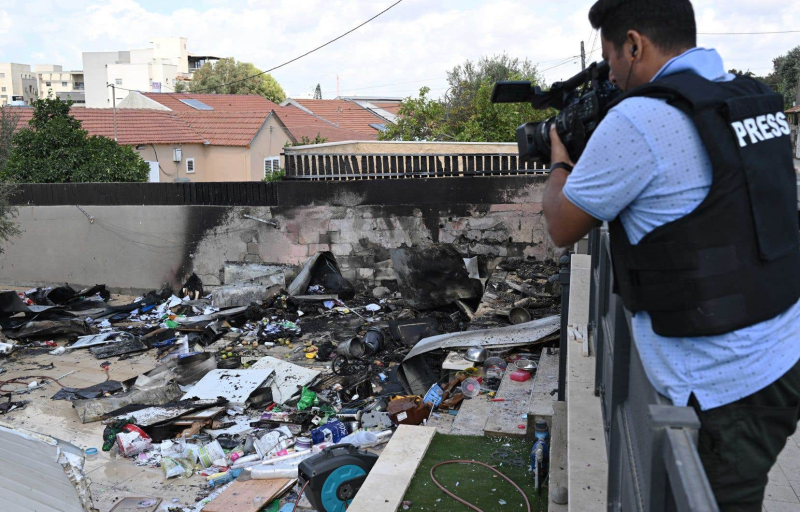Photo: Yuri Cortez Agence France-Presse Israeli strikes are intensifying in Gaza, and journalists face constant risks on the ground.
One of the first victims of the Israeli response, following the Hamas attack on October 7, was Ibrahim Mohammad Lafi. A young photojournalist, he was shot and killed while covering events in Beit Hanoun, near the Erez border crossing in the northeast of the Gaza Strip. He was 21.
Ibrahim is one of around twenty journalists killed since the start of Israel's war against Hamas — a death toll that continues to rise as the Israeli offensive on the Gaza Strip intensifies. denounce organizations protecting the rights of journalists.
Also read
This text is published via our Perspectives section.
According to Reporters Without Borders (RSF), 11 journalists died covering this war, including 9 in the Gaza Strip, “most, if not all, under Israeli bombings,” the organization specifies. In total, around the world, 36 journalists have lost their lives in the line of duty since the start of the year.
The toll is, however, heavier than we think: RSF notes that around ten journalists were also killed in their homes by Israeli strikes, even though they were not covering the conflict. The body is trying to determine whether they were targeted by the Israeli army because of their positions.
According to the Committee to Protect Journalists (CPJ), 29 journalists have lost their lives since October 7: 24 Palestinians, 4 Israelis and 1 Lebanese. For its part, the Palestinian Journalists' Union also counts a total of 24 journalists killed.
“A 360-degree war”
“When we are in the context of conflict [in the Gaza Strip], it’s a bit of a 360-degree war,” illustrates Guillaume Lavallée, journalist and former president of the Foreign Press Association (from 2022 to 2023), which represents foreign correspondents working in Israel, the West Bank and the Gaza Strip.
“There is no place to take refuge,” says the journalist on the line from Montreal. He was a correspondent in Israel and Palestine for a long time. Indeed, the Gaza Strip has been subject to an Israeli blockade since 2007, making entry and exit from the territory very difficult. Moreover, since October 7, the small territory has been under total siege: it is impossible to leave, and electricity, water, food and gas are no longer supplied by Israel.< /p>
“Journalists have to manage working in the field and being at risk, while having to manage their families, including their children, knowing that they cannot shelter them , explains Guillaume Lavallée. This is what makes it quite unique unfortunately [in Gaza]. This is what we saw [Wednesday], with the case of Wael Al-Dahdouh. »
Palestinian journalist and Gaza correspondent for Al Jazeera, Wael Al-Dahdouh lost his wife and two of his children in an Israeli airstrike on the Nusseirat refugee camp on October 25. While he remained in Gaza City to cover the Israeli offensive, his family took the road south to escape the bombings, reports the Qatari channel. Al-Dahdouh heard the news live.
If the dangers faced by journalists in the Gaza Strip increase, the community risks seeing a “media suffocation” of what is happening on the ground, warns RSF. A fear exacerbated in particular by Israel's online propaganda offensive through its various social network accounts.
Last week, the Israeli government introduced emergency measures allowing it to suspend media broadcasters and confiscate their equipment, or to target civilians if the content they broadcast were to “threaten security.” national or public order, or serve as a basis for “enemy propaganda,” Israeli media report.
These measures are decried by the Committee to Protect Journalists, which considers in particular that Al Jazeera, often targeted by the Israeli regime, would be at risk of censorship in this context.
In 2017, Israel also tried to close the channel's office in Jerusalem, suspend its broadcasting and withdraw the accreditation of its journalists. In 2021, the building housing the offices of Al Jazeera as well as those of the Associated Press in Gaza was destroyed by an Israeli strike.
“They found themselves in the middle of war without a place to work », argues Mr. Lavallée. In 2021, these journalists had to practice their profession in temporary workplaces, before being able to rebuild new premises, “without knowing if they could stay there [for a long time]. Because as soon as there is another war, there is no longer a safe place.”
Such a risky situation in Israel
“Journalists are civilians doing essential work in times of crisis and should not be targeted by warring parties,” said CPJ Middle East and North Africa coordinator Sherif Mansour. press release.
“Journalists in Gaza are at exponential risk. But their colleagues in the West Bank and Israel also face threats, attacks and intimidation in order to obstruct their essential coverage of this conflict,” he adds to Devoir, through the voice of Zoe Simbolon, CPJ communications officer.
Guillaume Lavallée also emphasizes that Israeli journalists are also at risk in the face of Hamas rocket attacks from Gaza, which have also been multiplying since October 7. “There is also rocket debris. Even if there is an Israeli anti-missile shield, [journalists] never know where it might fall. There is a fairly permanent risk. »

